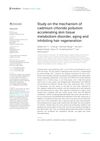TLDR Low color temperature light (1900 K) benefits health by promoting melatonin, protecting eyes, and aiding healing.
The study evaluated the biological effects of four artificial lights with different color temperatures (1900 K, 3000 K, 4000 K, and 6600 K) on human and murine models, involving 152 person-times. The low color temperature light (1900 K) was found to have several benefits compared to higher color temperature lights. It promoted melatonin and glutamate secretion, protected human eyes, and accelerated wound healing and hair regeneration. These findings suggested that the 1900 K light could offer significant health benefits in daily life.
 19 citations
,
February 2018 in “Lasers in Medical Science”
19 citations
,
February 2018 in “Lasers in Medical Science” Red light and LED treatments help hair grow by activating a specific cell signaling pathway.
 14 citations
,
April 2016 in “Cell Transplantation”
14 citations
,
April 2016 in “Cell Transplantation” Neural stem cell extract can safely promote hair growth in mice.
 9 citations
,
January 2016 in “PubMed”
9 citations
,
January 2016 in “PubMed” Stem cell therapy could be a promising alternative for hair regrowth with fewer side effects.
 60 citations
,
December 2015 in “Lasers in Medical Science”
60 citations
,
December 2015 in “Lasers in Medical Science” Low-level laser therapy is safe and can increase hair growth for male and female pattern hair loss.
 147 citations
,
January 2014 in “American Journal of Clinical Dermatology”
147 citations
,
January 2014 in “American Journal of Clinical Dermatology” Laser device increases hair density, safe for treating hair loss in men and women.
 4 citations
,
October 2022 in “Frontiers in public health”
4 citations
,
October 2022 in “Frontiers in public health” Cadmium chloride pollution can cause skin disorders, speed up aging, and prevent hair growth.
 August 2025 in “Frontiers in Pharmacology”
August 2025 in “Frontiers in Pharmacology” Periplaneta americana extract helps hair regrowth by reducing inflammation and improving skin bacteria balance.
 1 citations
,
June 2023 in “Cells”
1 citations
,
June 2023 in “Cells” Exosomes could be a promising way to help repair skin and treat skin disorders.
 August 2022 in “Metabolites”
August 2022 in “Metabolites” Different types of skin on mice have unique chemical profiles related to how they grow and react to stress.
November 2025 in “International Journal of Molecular Sciences” PRP shows promise in healing and regeneration but needs standardized protocols for consistent results.








